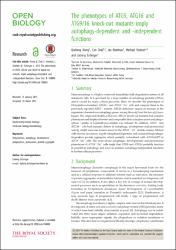The phenotypes of ATG9, ATG16 and ATG9/16 knock-out mutants imply autophagy-dependent and -independent functions
Özet
Macroautophagy is a highly conserved intracellular bulk degradation system of all eukaryotic cells. It is governed by a large number of autophagy proteins (ATGs) and is crucial for many cellular processes. Here, we describe the phenotypes of Dictyostelium discoideum ATG160(-) and ATG9(-)/16(-) cells and compare them to the previously reported ATG9(-) mutant. ATG16 deficiency caused an increase in the expression of several core autophagy genes, among them atg9 and the two atg8 paralogues. The single and double ATG9 and ATG16 knock-out mutants had complex phenotypes and displayed severe and comparable defects in pinocytosis and phagocytosis. Uptake of Legionella pneumophila was reduced. In addition, ATG9(-) and ATG16(-) cells had dramatic defects in autophagy, development and proteasomal activity which were much more severe in the ATG9(-)/16(-) double mutant. Mutant cells showed an increase in poly-ubiquitinated proteins and contained large ubiqui-tin-positive protein aggregates which partially co-localized with ATG16-GFP in ATG9(-)/16(-) cells. The more severe autophagic, developmental and proteasomal phenotypes of ATG9(-)/16(-) cells imply that ATG9 and ATG16 probably function in parallel in autophagy and have in addition autophagy-independent functions in further cellular processes.

















